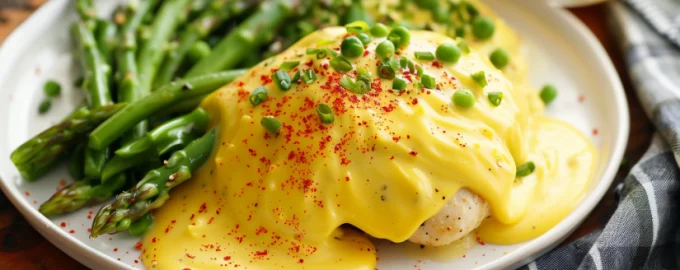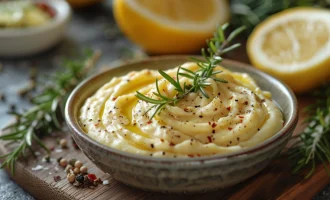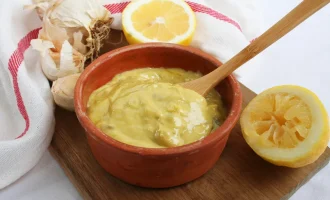Hollandaise sauce, often referred to as Dutch sauce, is a classic emulsion of egg yolks, liquid (usually water or lemon juice), and melted butter, seasoned with salt, and sometimes white pepper or cayenne. It’s one of the five mother sauces in French cuisine, praised for its rich, buttery flavor and smooth, velvety texture. While its exact origins are debated, hollandaise sauce became widely recognized in France in the 19th century and is now a staple in French and international cuisines alike. It’s famously paired with Eggs Benedict, but its use extends to vegetables, fish, and as a key component in other dishes like asparagus with hollandaise, salmon, or even over steamed potatoes.
- Egg yolks 60 g
- Cold water 15 ml
- Fresh lemon juice 15 ml
- Unsalted butter 125 g
- Salt 2 g
- Cayenne pepper or white pepper A pinch
- Begin by separating the egg yolks from the whites. Place the yolks in a heatproof bowl. Measure out all other ingredients so they are ready to use. The butter should be melted and kept warm.
- Add the cold water to the egg yolks. Whisk vigorously until the mixture is light and frothy. This introduces air and volume to the base.
- Set the bowl over a pot of gently simmering water, ensuring the bottom of the bowl doesn’t touch the water. This double boiler method provides gentle heat to cook the yolks without scrambling them.
- Continue whisking the yolk mixture constantly as it heats. It will begin to thicken. Once it leaves a trail when the whisk is lifted, remove the bowl from the heat.
- Slowly drizzle in the melted butter while whisking vigorously. Begin with a few drops at a time, then proceed to a thin stream, ensuring each addition is fully incorporated before adding more. This slow addition and constant whisking create an emulsion, giving the sauce its smooth, thick texture.
- Once all the butter is incorporated, stir in the lemon juice, salt, and a pinch of cayenne or white pepper. Adjust the seasoning and acidity to taste.
- Hollandaise sauce is best served fresh and warm. If it needs to be held for a short period, keep it in a warm spot, like over a pot of warm water, stirring occasionally.
Storage Tips
Hollandaise sauce is best enjoyed fresh and does not store well due to its emulsion nature. If necessary, it can be kept warm for about an hour before serving. Reheating or prolonged storage can cause the sauce to break or curdle.
Useful Properties of the Main Ingredient
Egg yolks are a nutritional powerhouse, rich in vitamins, minerals, and healthy fats. They contain choline, which supports brain health, and antioxidants like lutein and zeaxanthin, which promote eye health.
Interesting Facts
- Culinary Staple: Hollandaise is classified as one of the French cuisine’s five mother sauces, a testament to its foundational role in cooking.
- Versatility: While classic dishes like Eggs Benedict are the most famous uses, hollandaise sauce’s rich flavor and creamy texture make it a versatile accompaniment to many dishes.
- Historical Misnomer: Despite its name, hollandaise sauce is more French than Dutch. The name may have originated from the historical association of the Netherlands with butter production.
Creating hollandaise sauce is a testament to the art of cooking, requiring patience and technique to achieve the perfect emulsion. Its luxurious texture and rich flavor make it a beloved addition to a variety of dishes, elevating them with a touch of elegance.






